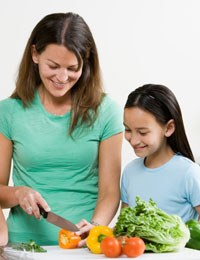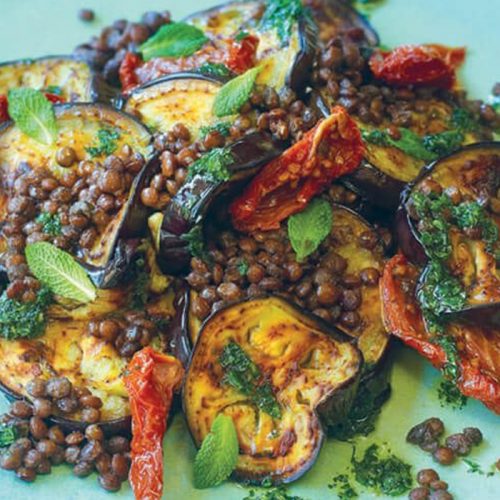
Fruit and veges are inexpensive, healthy and delicious and too many of our kids don’t eat enough of them for good health. Here are some tips for increasing the fruit and vege content in a way your child will eat.
According to findings of the 2002 National Children’s Nutrition Survey:
- only about two out of five children met the recommended number of serves of fruit (at least two per day);
- about three out of five children met the recommended number of serves of vegetables (three or more per day);
- 31% of children were either overweight or obese.
The eating habits we learn as children are likely to become a lifelong pattern, so if our children eat poorly they are more likely to become adults with unhealthy diets.
Whether your children are still in nappies or always asking to borrow your car, it’s never too late to make positive changes to their eating habits. Children like what they know, and they eat what they like. Familiarisation is everything.
Here are some of the techniques I’ve found work well.
Hide and seek
While it’s important for children to eat fruit and vegetables that aren’t disguised in any way, using them as ingredients is a good way of improving the nutritional quality of a meal. Try the following ways of increasing their vegetable intake:
- Meatballs or meat loaf can be made by augmenting mince with grated zucchini, carrot, potato and onion. You can also add rolled oats, wholemeal breadcrumbs and garlic.
- Bolognese sauce is another candidate for grated vegetable therapy. Add mashed pumpkin for delicious smoothness.
- Make muffins and cakes with fruit puree, grated carrot or zucchini, mashed kumara or pumpkin, pureed prunes or mashed banana.
- Add finely chopped pumpkin and kumara to casseroles; they’ll dissolve and thicken the sauce perfectly.
- Hide a sprinkling of finely chopped or grated vegetables under the cheese on a homemade pizza.
- Add slices of cucumber, capsicum, grated carrot and a piece of lettuce to the kids’ lunchtime sandwiches.
- Make smoothies and call them milkshakes.
15 ways to make fruit and veges fun
- Make a big bowl of fresh fruit salad and mix some marshmallows or chocolate buttons through it: it’ll feel like a real treat, but it’s still mostly fruit.
- Make a breakfast fruit platter: bite sized pieces that can be eaten with a fork.
- Add cubes of fruit to jellies and serve in small pots.
- Get a vegetable slicer and use it to make raw vegetables easier to eat and more appealing.
- Never underestimate a bag of carrots: throw them in the picnic basket – they’re as fun to eat as an apple.
- Dip celery pieces into vegemite and call them ants on sticks. Do the same with peanut butter or cottage cheese.
- Use microwaved potatoes as an after school snack: slash them open and insert slices of cheese and salami.
- Cut corn on the cob into little wheels just 2cm wide – they make great finger food.
- Chop fresh asparagus into pea sized pieces and include in stir fries or stir into pasta.
- Make fruit and veg kebabs on small sticks.
- Puree fresh or frozen fruit, mix with some fruit juice and freeze in popsicle containers.
- Get kids to plant some vegetables in the garden – their very own – and watch them grow.
- Include fruit in savoury salads – grapes, pineapple, mango and dried fruit.
- Crunchy, raw vegetables with dip.
- Give your kids a ‘ploughman’s lunch’: bread roll, salad vegetables chopped into bite-sized pieces and a hunk of cheese.
Tips for achieving 5+ a day
Child psychologist Anna Malone, Triple P positive parenting programme, has the following tips:
- Avoid excessive emotion: eating fruit and vegetables is a normal part of life, so keep it normal. Don’t plead, shout or bribe.
- Give them small amounts of lots of different things, remember that a child’s serving is smaller: use their handful not yours and for new tastes, serve tiny portions.
- Be a great role model by eating a wide range of fruit and vegetables with your children – older siblings can also be role models.
- Say “this is what we’re eating for this meal”, and don’t give in; if food is left on the plate, don’t scold or offer any alternatives. Your kids will not starve. Get them to help with meal preparation sometimes – slicing the vegetables or chopping fruit.
- Let them help with fruit and vegetable shopping. Show them the frozen vegetables too. With you as a coach, preschoolers can learn (and then eat) their alphabet in a greengrocer’s shop.
- Give older children their own shopping list: getting them involved in choosing the food makes them more likely to try it.
- Include fruit and vegetables in their lunch: baby carrots and cherry tomatoes are often a hit and their two pieces of fruit a day and one or two serves of vegetables can easily be achieved by lunchtime.
Did you know?
- Families that eat together are much more likely to have five or more servings of fruit and vegetables a day.
- A child’s first exposure to flavours occurs before birth in the intrauterine environment; a mother’s dietary choices also influence the flavour of breast milk; exposure to flavours is the first step to familiarisation.
- In both boys and girls, preference for vegetables increases with age.
www.healthyfood.com










